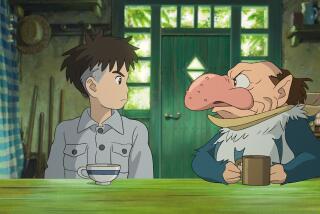Empty nests, sporks and existential crises take ‘Toy Story 4’ into Oscar contention
Josh Cooley and Stephany Folsom had some pretty weird ideas they wanted to introduce into perhaps the most “storied” of all animated franchises. A talking spork that loved being in the trash? A depressed Canadian Evel Knievel-like toy?
The director and co-writer, respectively, would work with the original Pixar team to blend old and new to give “Toy Story 4” texture and meaning unusual for most sequels. But first, they had to get over the awe of stepping into something that helped shape their own childhoods. Fortunately, the films were never aimed at their childhoods.
“I’ve worked there for 30 years and I’ve never thought about” aiming movies at kids, says co-writer Andrew Stanton, who has collaborated on every “Toy Story” movie. “I’ve never been in a single meeting or discussion where anybody’s talked about children. We’re just trying to talk to ourselves and make sure anybody who wants to watch it is included.
“How sarcastic could we be, how adult could we talk? How sophisticated could we be cinematically without excluding anybody? It turns out, you can go really far!”
“That’s one of the fantastic things about these films: It’s not just about the kids, it’s about the toys,” says Folsom, one of those new kids on the “Toy Story” block. “And it kind of charts every age of growing up, and what it’s like to be a kid, and what it’s like to be a parent.”
Folsom and first-time feature director Cooley were charged with following up one of the most successful animated films ever — the Oscar-winning, billion-dollar-grossing “Toy Story 3,” featuring a superb Oscar-nominated screenplay by Michael Arndt. Their “Toy Story 4” finds franchise hero Woody (voiced by Tom Hanks) adjusting to life after his boy Andy has handed him down to little Bonnie. Though Bonnie doesn’t play with him much, the loyal cowboy tries to support her new favorite, trash-craft creation Forky (Tony Hale). It would be fair to call Forky a bizarre creation. He’s also perhaps the most lovable character in the film.
The toys go on a trip that solves the mystery of what happened to Woody’s beloved Bo Peep (Annie Potts) and leads to the steady cowboy muddling through an existential crisis and redefining his raison d’etre. Those are fairly grownup themes of life transitions in an animated movie.
“I know the joy and the sense of excitement I got, going to those movies in the theater,” Cooley says. “All that joy I felt as an audience member, I wanted to bring into this film. It needed to continue that legacy and that joy. I had a lot of sleepless nights.”
He and Folsom weren’t thrown in the deep end alone, though.
“I don’t think you can do ‘Toy Story’ without the founding members of Pixar, because it is them,” Folsom says.
The “Toy Story” originators went on a retreat to the same house they rented in 1992 to brainstorm the first movie. There, they came up with a continuation that would resonate with them personally.
“Woody’s journey really comes from Andrew,” Folsom says. “He’s at a point in his life where the kids have left the nest and he’s feeling that. I think the Bo Peep of it all came from me because I recently lost my mom and that character had a horrible trauma and a horrible loss and had to learn how to redesign herself. So in a weird way, it was like the two psychologies of what was going on in our lives, we infused that into the story and it made it what it is.”
“It was what we could do that most sequels can’t. We can embrace the actual time that has passed between the release of these movies.”
— Andrew Stanton
It was that passage of time that led the way, Stanton says. “It was what we could do that most sequels can’t. We can embrace the actual time that has passed between the release of these movies. Because these toys do not age, we can follow along with them in the same path that our lives have gone and glean from the things we’ve learned about life and the perspectives that have changed, and capitalize on them. [This time] my kid was going to college. We could project the feelings we had as parents onto the toys.”
Stanton and previous directors and writers Lee Unkrich and Pete Docter mentored Cooley, sharing secrets of the franchise. Some of the other help was, shall we say, succinct.
“Michael Arndt was at the studio when I first got hired, and I said to him, ‘I don’t know how I’m going to live up to what you did,’ and he said, ‘Ehh, you’ll be fine,’ ” Folsom says.
Though its opening wasn’t gangbusters, “Toy Story 4” went on to gross more than $1 billion. “There were waves of responses,” says Cooley. “Before it came out, it was, ‘Why are you making this movie?’ As people saw it, the questions changed, the responses became, ‘I really enjoyed it.’ I was in Mexico after a press screening and people were crying as they’re asking me the questions.”
It’s impacted new childhoods too. “I was walking through the park with my dog and I saw some kids at a picnic table and they were making their own Forkys!”
More to Read
Only good movies
Get the Indie Focus newsletter, Mark Olsen's weekly guide to the world of cinema.
You may occasionally receive promotional content from the Los Angeles Times.











